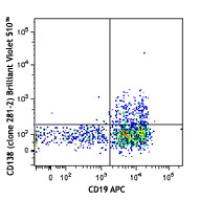-
Sign In
-

-
 Sony Biotechnology
Sony Biotechnology
-

-
 Sony Biotechnology
Sony Biotechnology
Brilliant Violet 510™ anti-mouse CD138 (Syndecan-1)
Antibodies Single
Sony
281-2
Flow Cytometry
Rat IgG2a, κ
Mouse
Mouse mammary gland epithelial cell line NMuMG
50 µg
1312605
$290.00
Description
CD138, a member of the syndecan protein family, is a type I integral membrane heparin sulfate proteoglycan also known as Syndecan-1. Syndecan-1 participates in cell proliferation, cell migration, and cell matrix adhesion via interaction with collagen, fibronectin, and other soluble molecules (such as FGF-basic). It is expressed on normal and malignant plasma cells, pre-B cells, mesenchymal cells, epithelial cells, and endothelial cells.
Formulation
Phosphate-buffered solution, pH 7.2, containing 0.09% sodium azide and BSA (origin USA).Recommended Usage
Each lot of this antibody is quality control tested by immunofluorescent staining with flow cytometric analysis. For flow cytometric staining, the suggested use of this reagent is ≤0.5 microg per million cells in 100 microL volume. It is recommended that the reagent be titrated for optimal performance for each application.
Brilliant Violet 510™ excites at 405 nm and emits at 510 nm. The bandpass filter 510/50 nm is recommended for detection, although filter optimization may be required depending on other fluorophores used. Be sure to verify that your cytometer configuration and software setup are appropriate for detecting this channel. Refer to your instrument manual or manufacturer for support. Brilliant Violet 510™ is a trademark of Sirigen Group Ltd.
This product is subject to proprietary rights of Sirigen Inc. and is made and sold under license from Sirigen Inc. The purchase of this product conveys to the buyer a non-transferable right to use the purchased product for research purposes only. This product may not be resold or incorporated in any manner into another product for resale. Any use for therapeutics or diagnostics is strictly prohibited. This product is covered by U.S. Patent(s), pending patent applications and foreign equivalents.
References
1. Jalkanen M, et al. 1985. J. Cell. Biol. 101:976. (FC)
2. Miettinen H, et al. 1994. J. Cell. Sci. 107:1571. (IF)
3. Li Q, et al. 2002. Cell 111:635. (IF, IHC)
4. McCarthy BA, et al. 2012. BMC Cancer. 12:203. (IHC)


